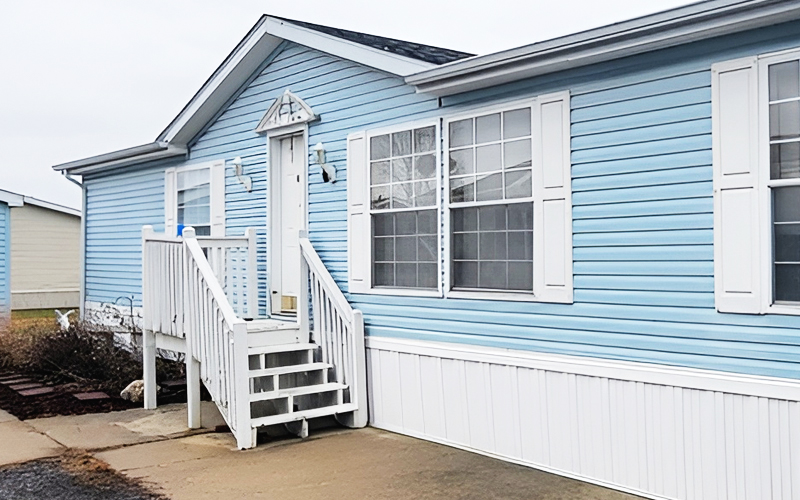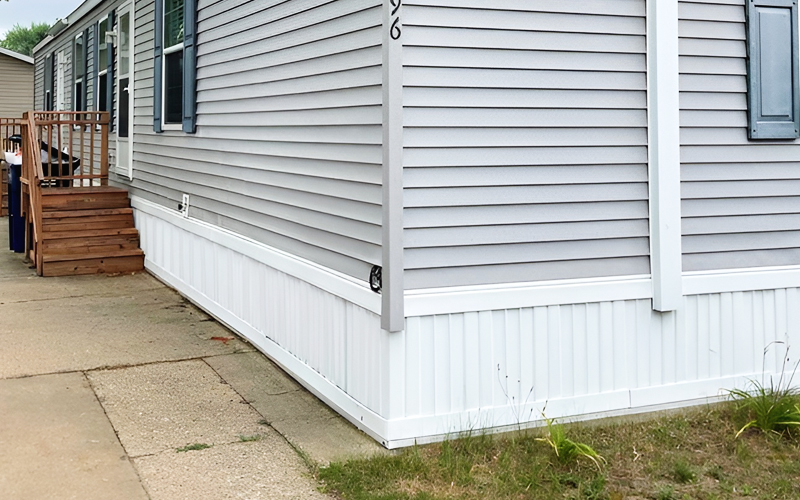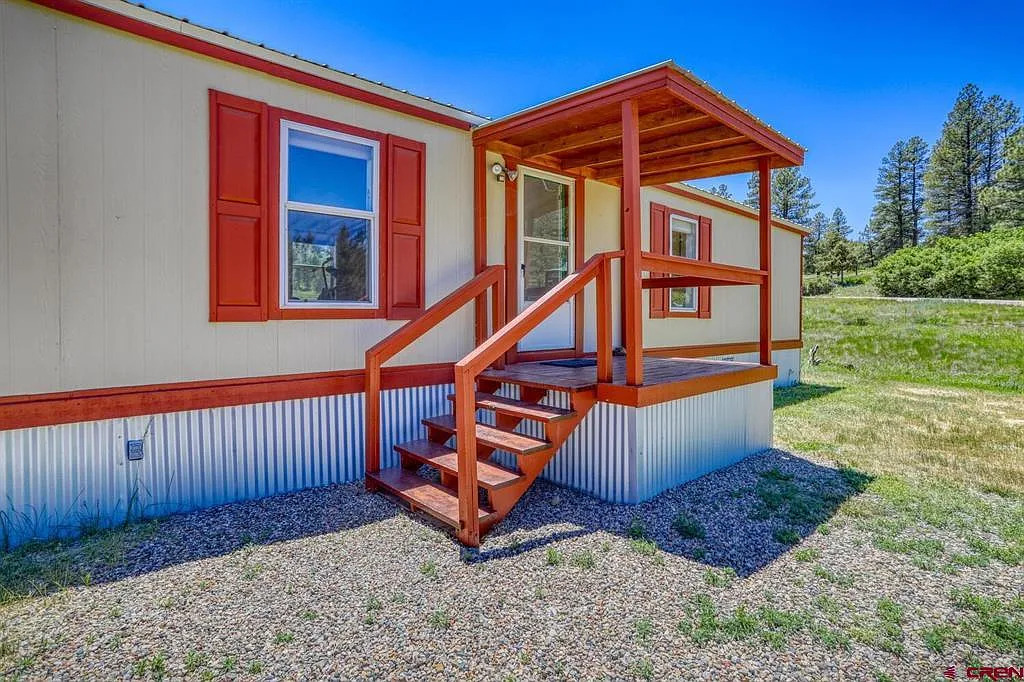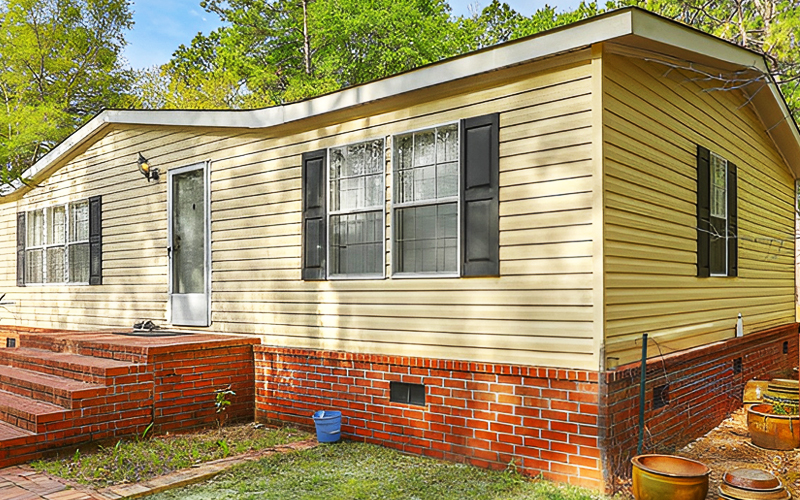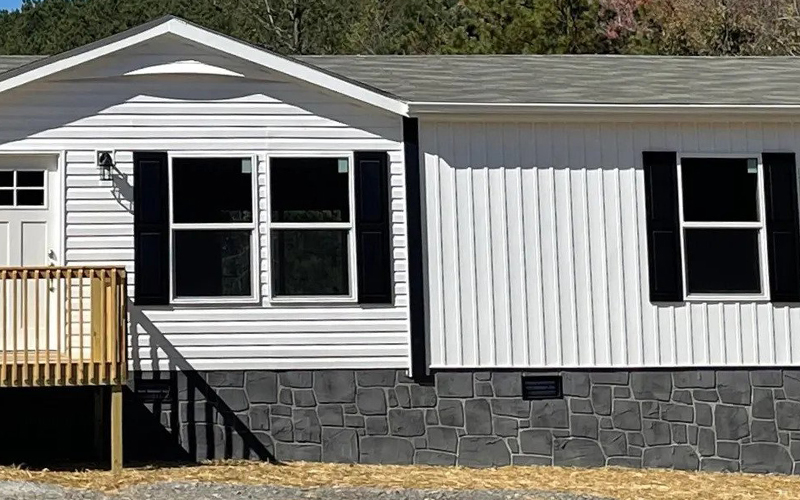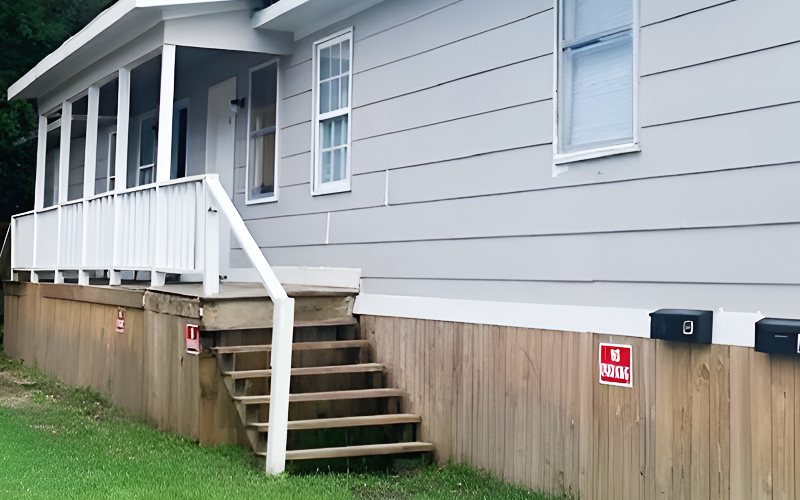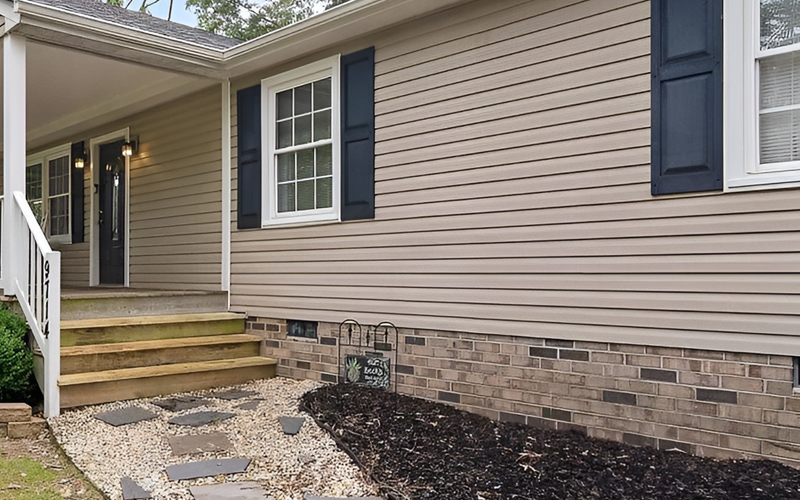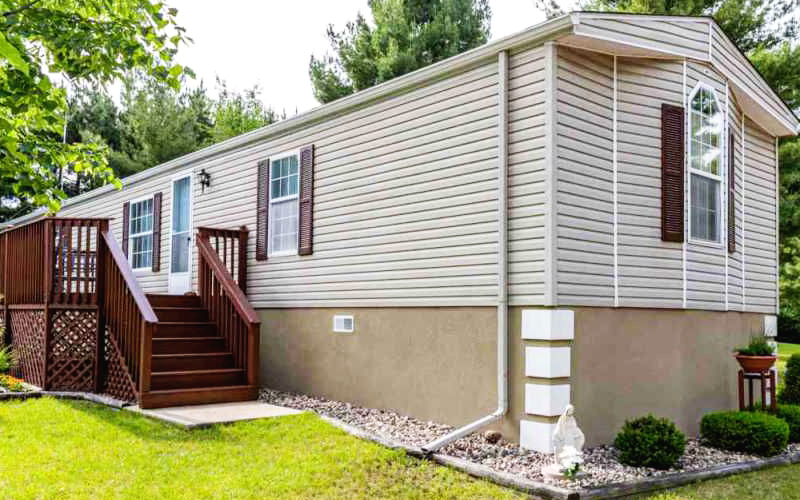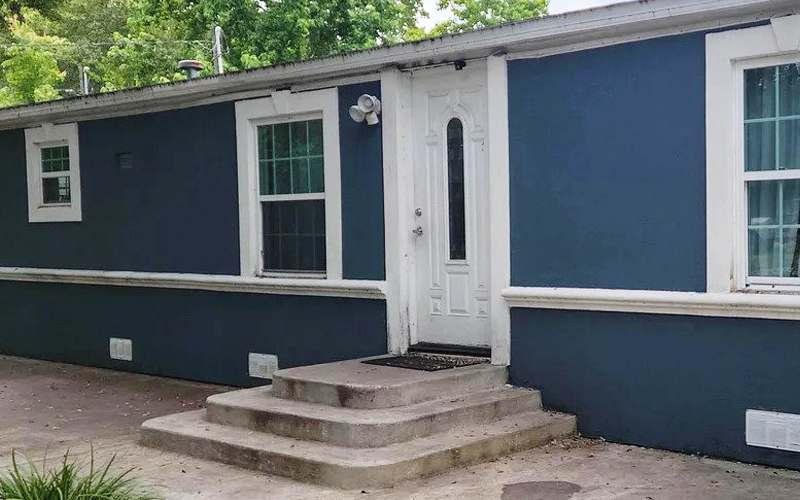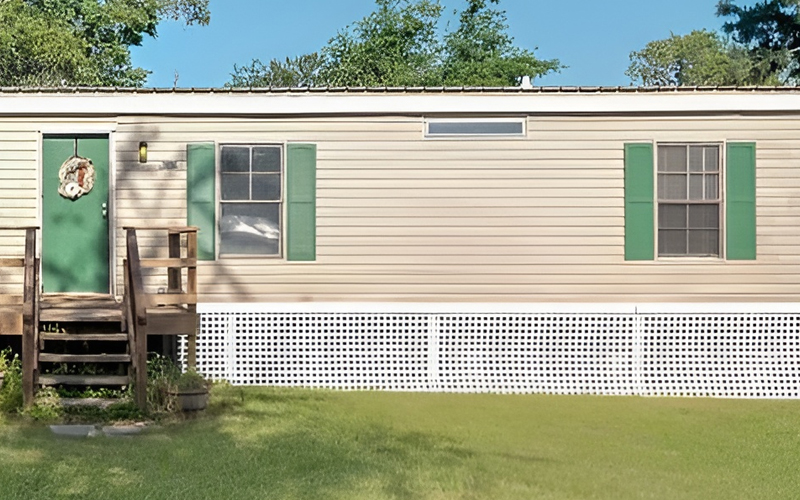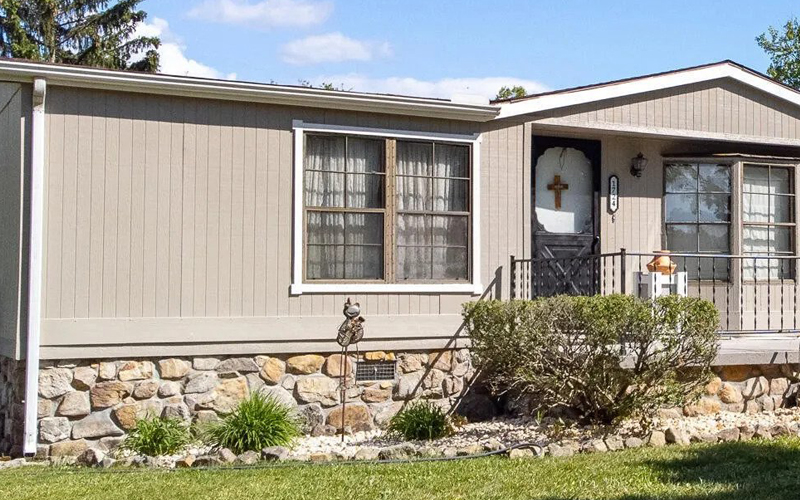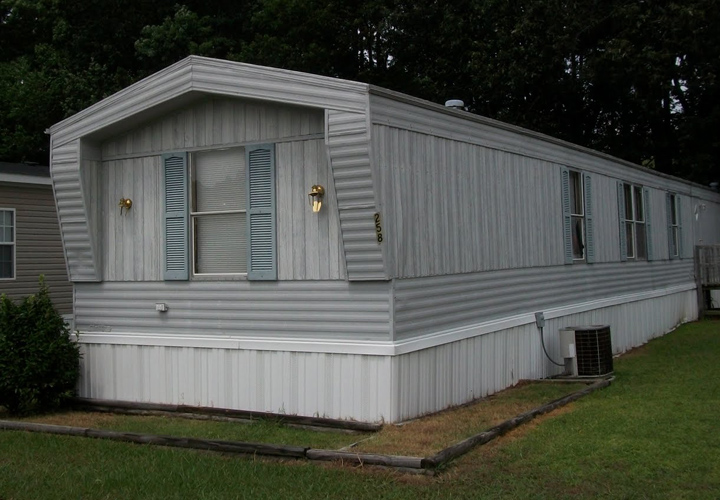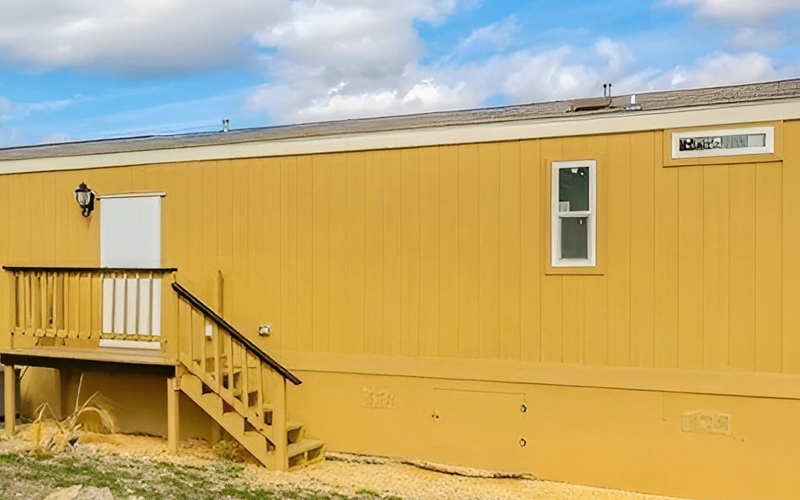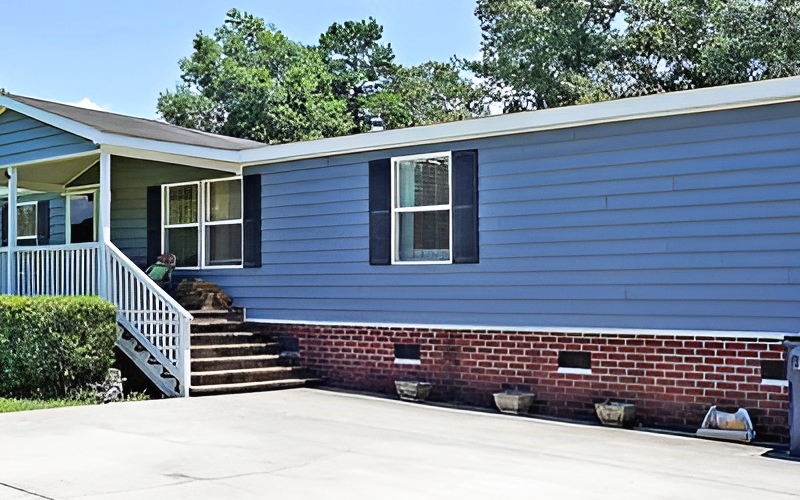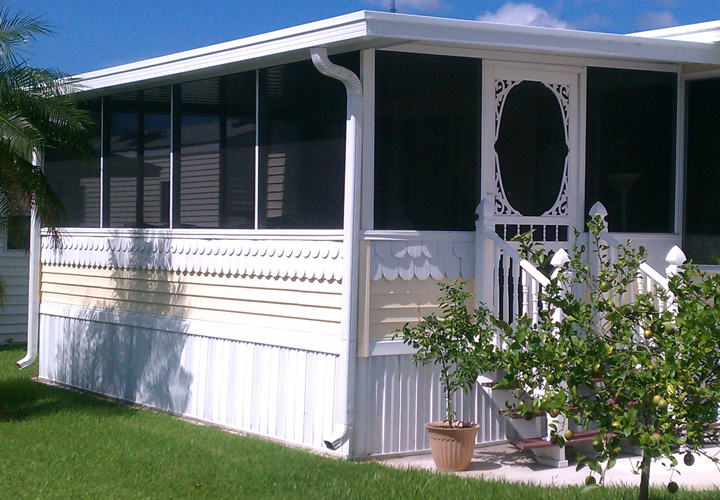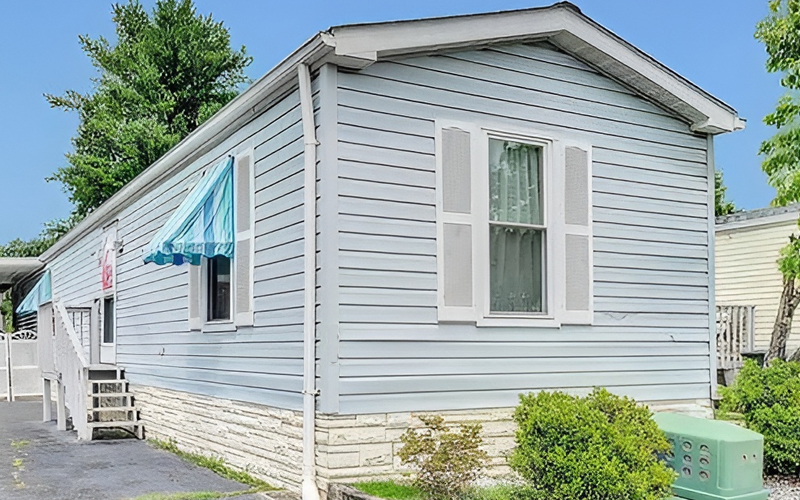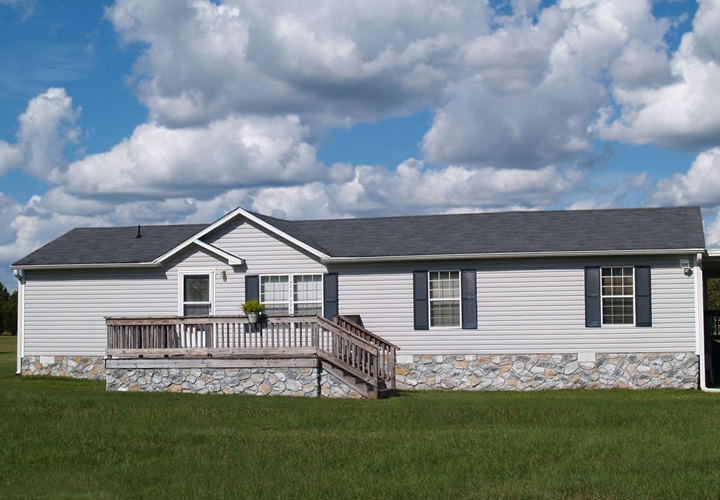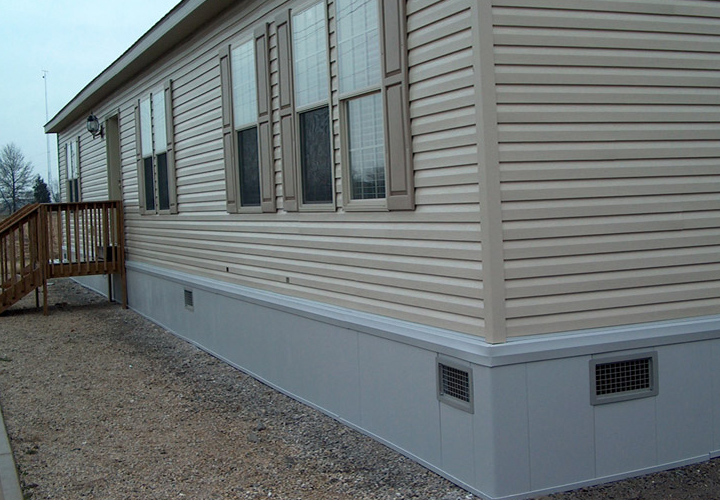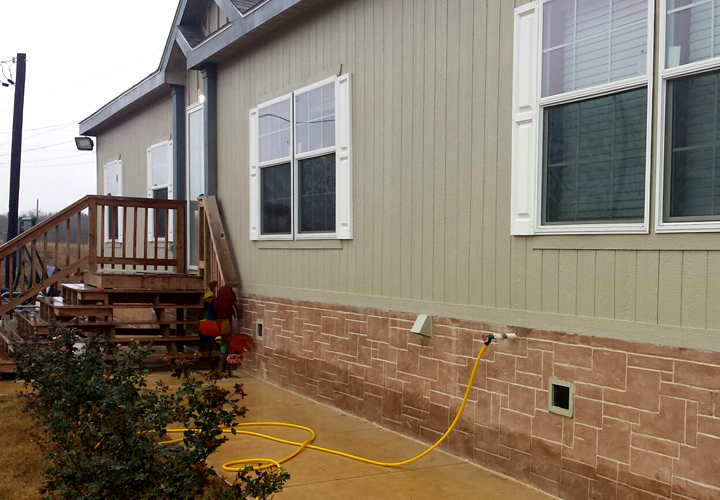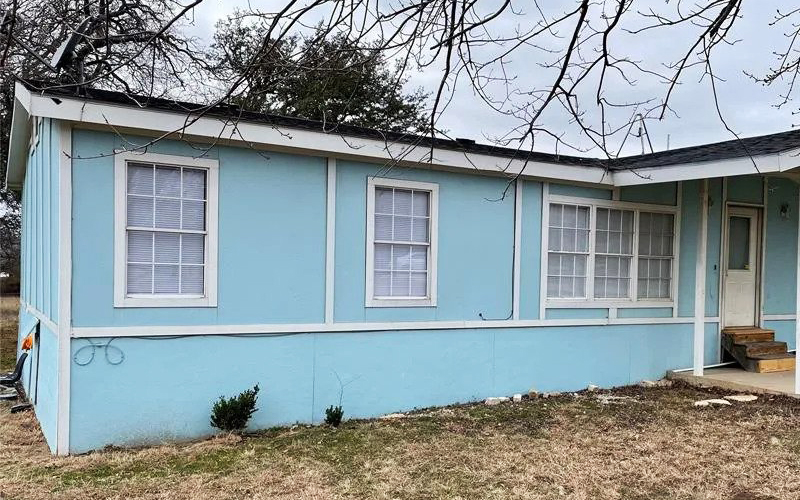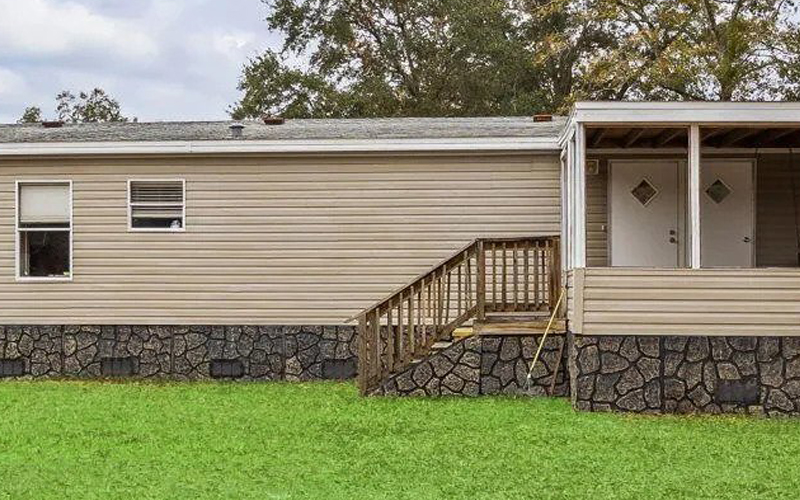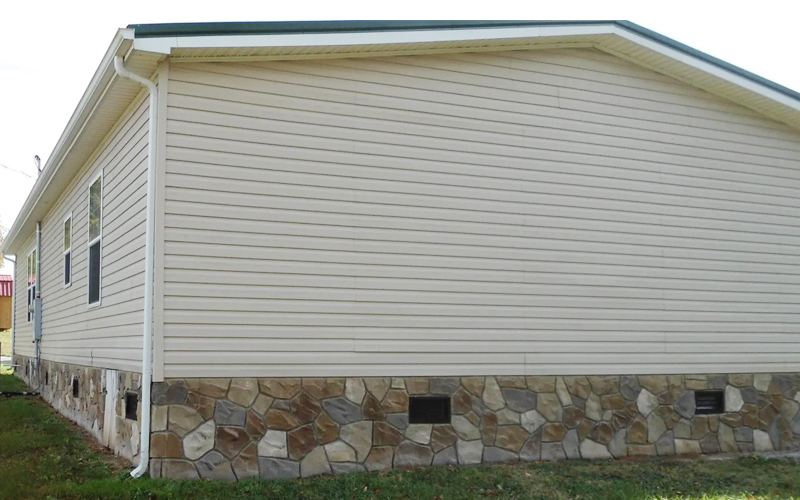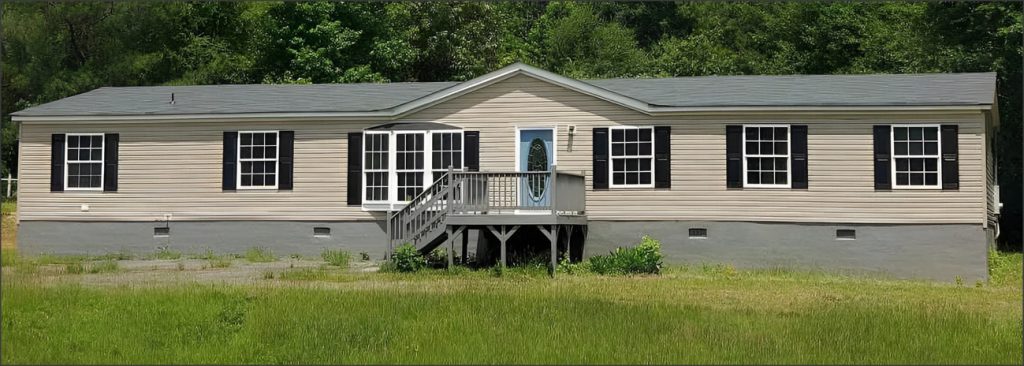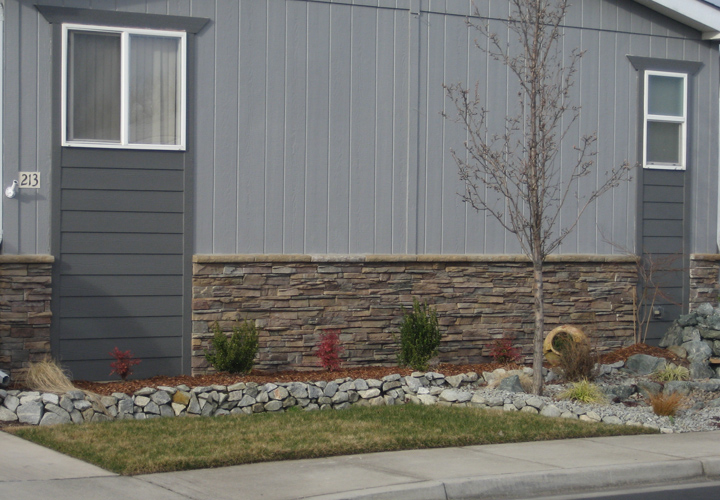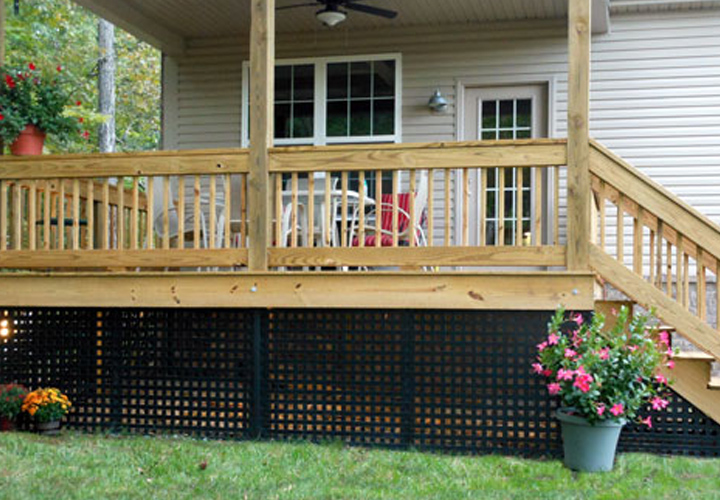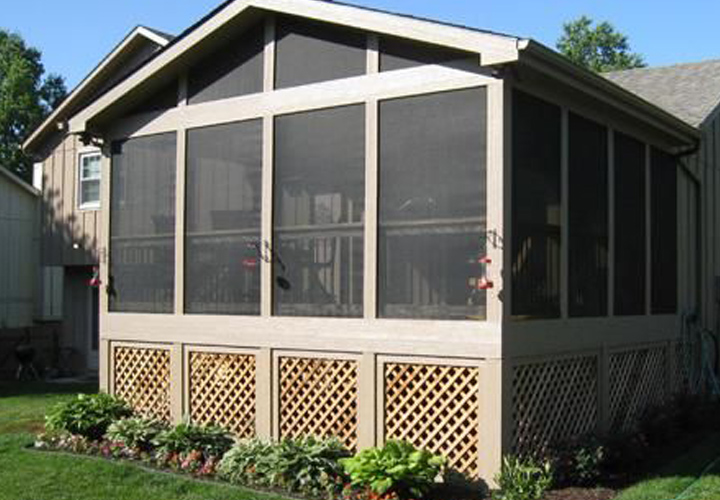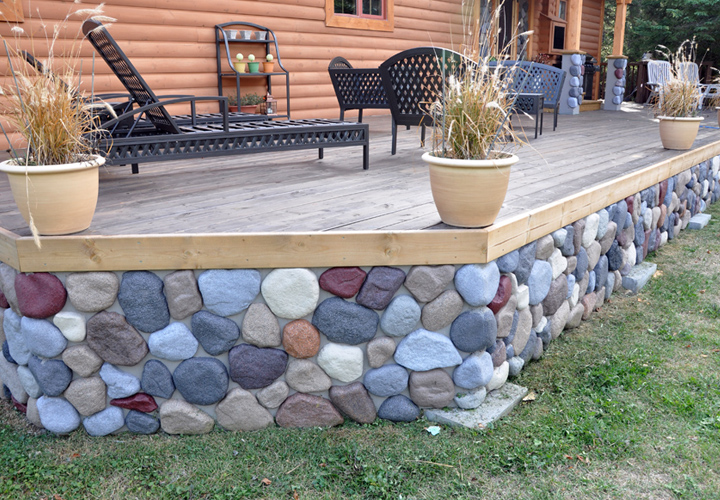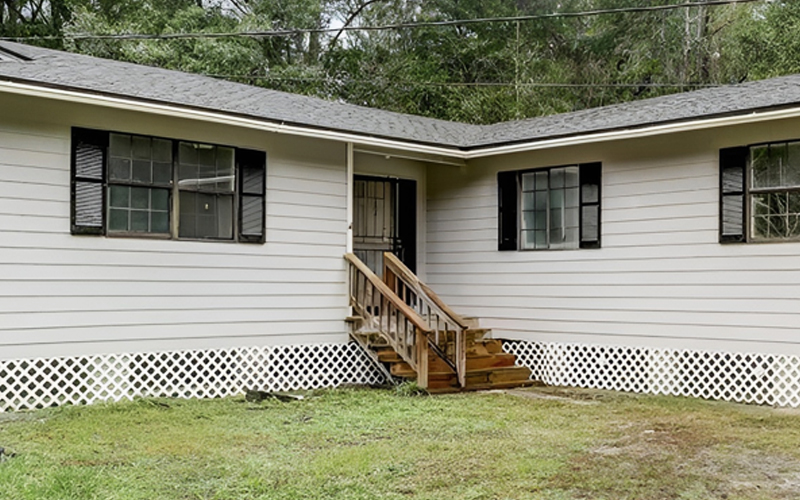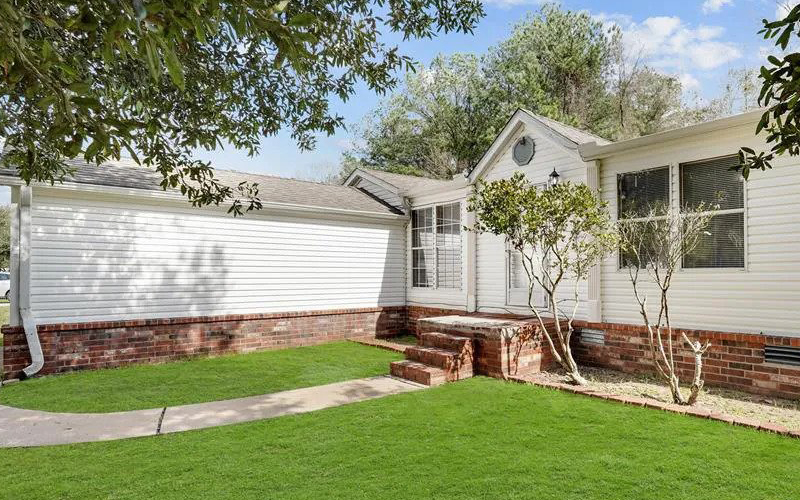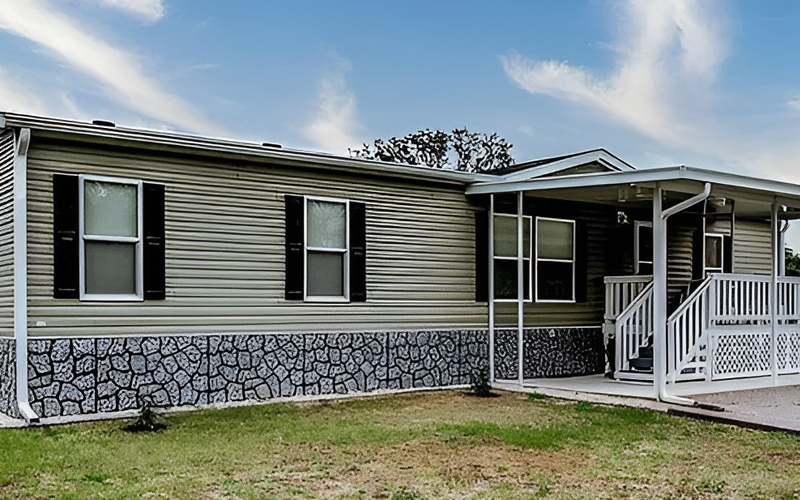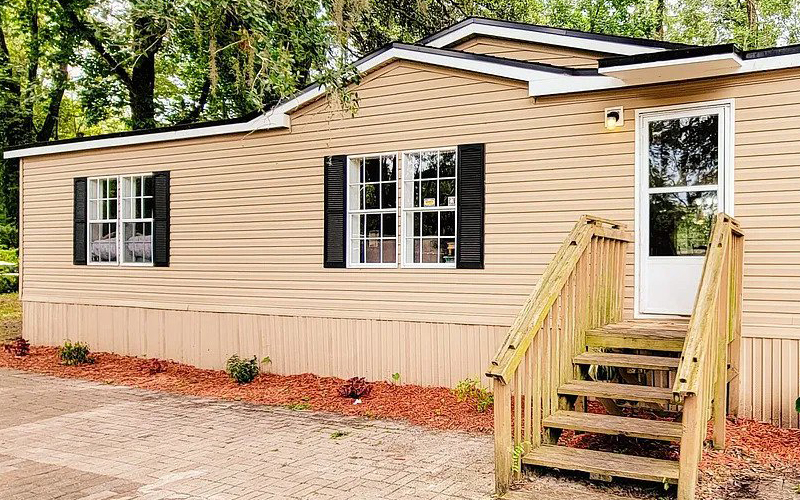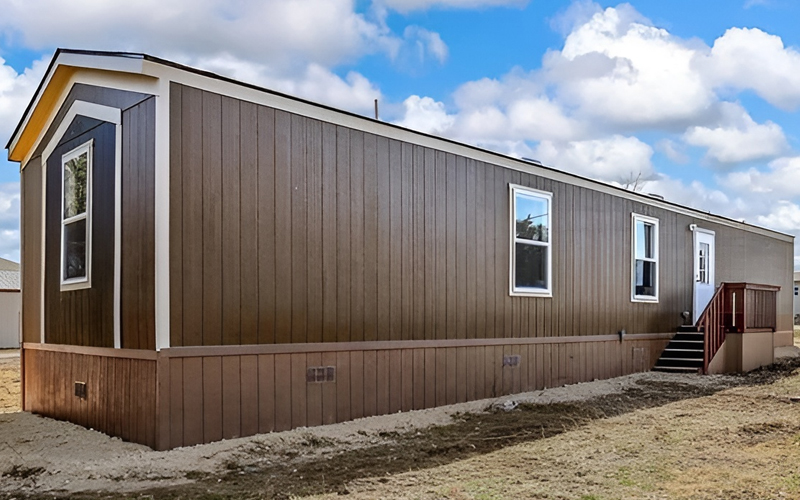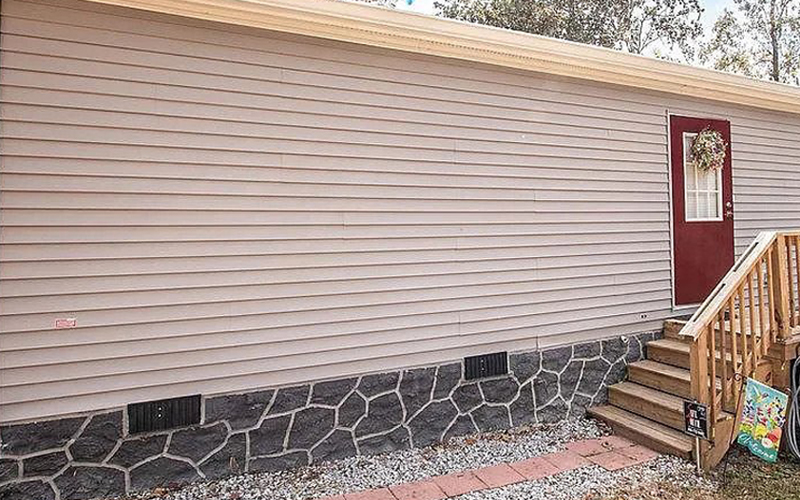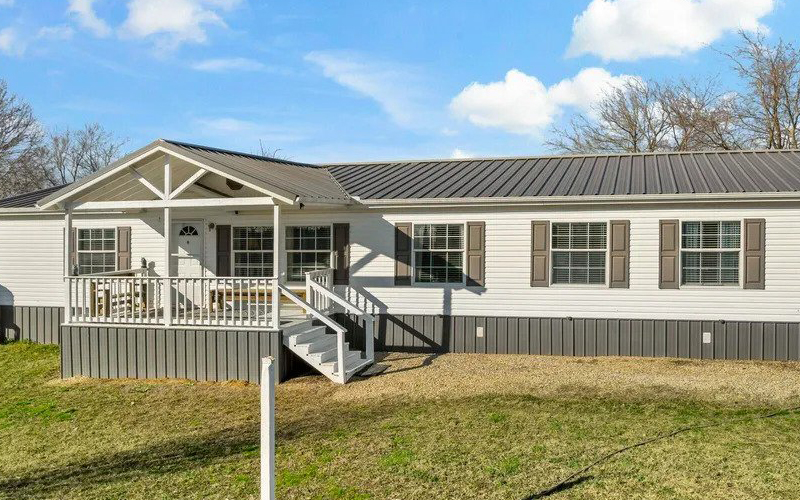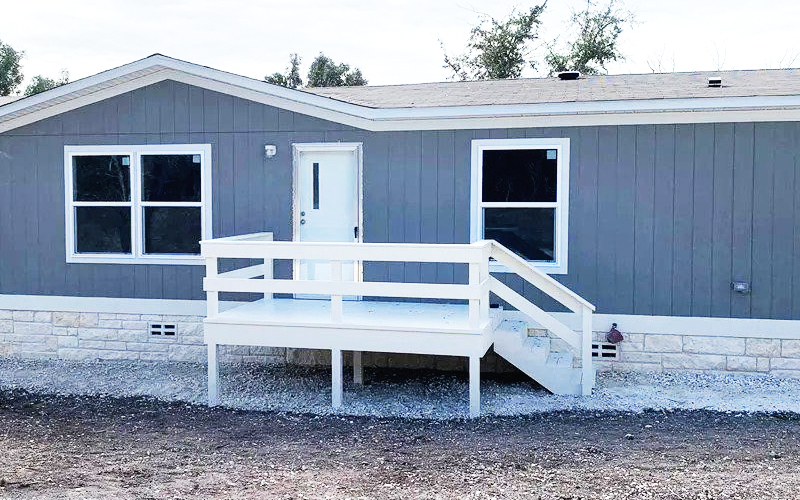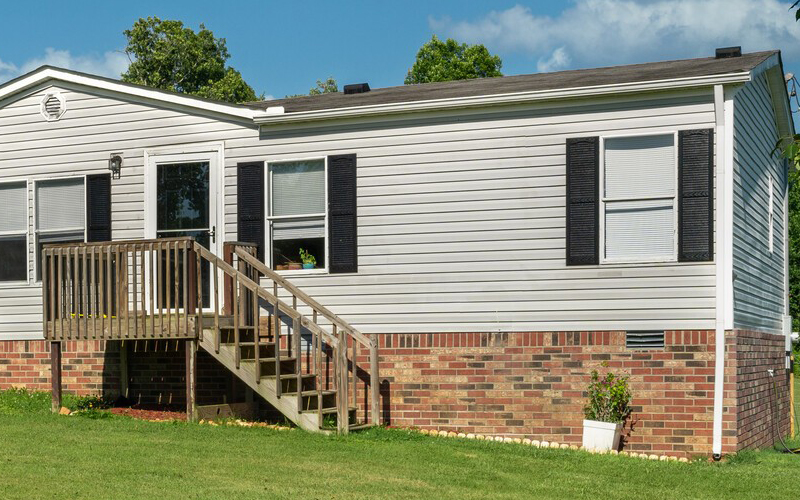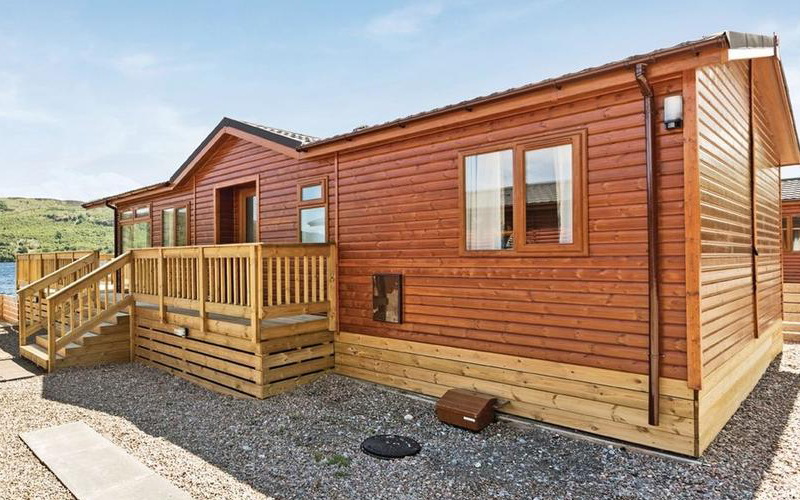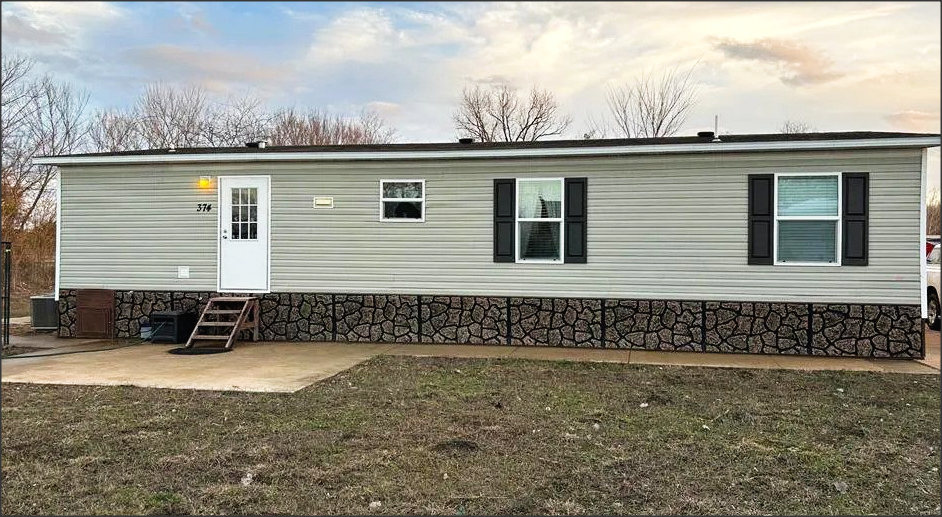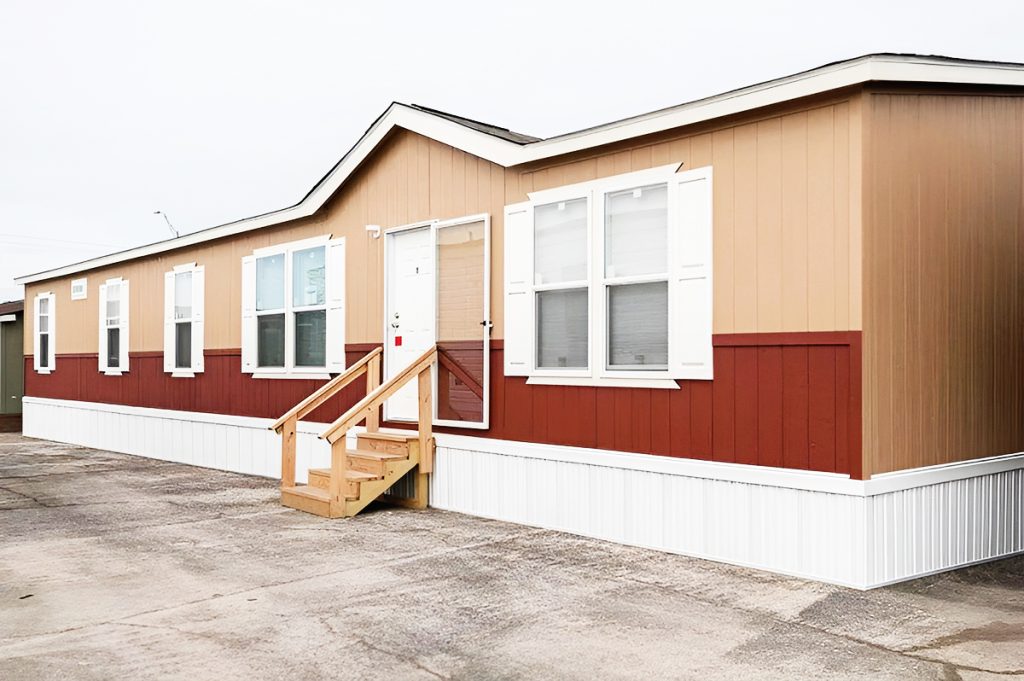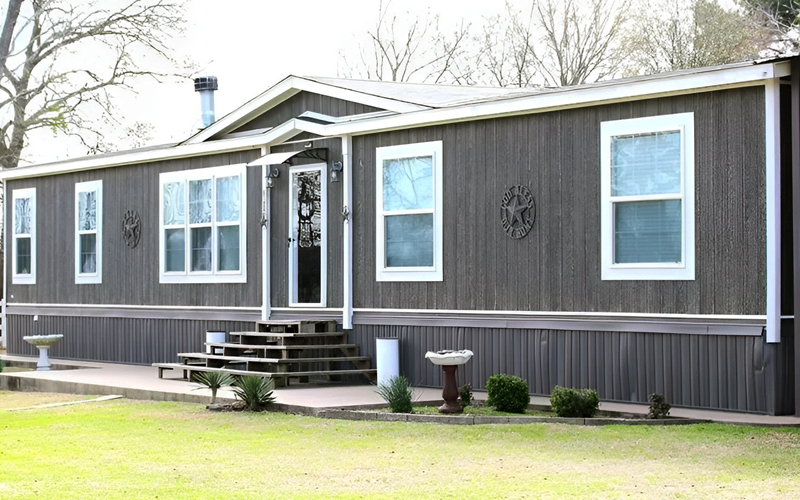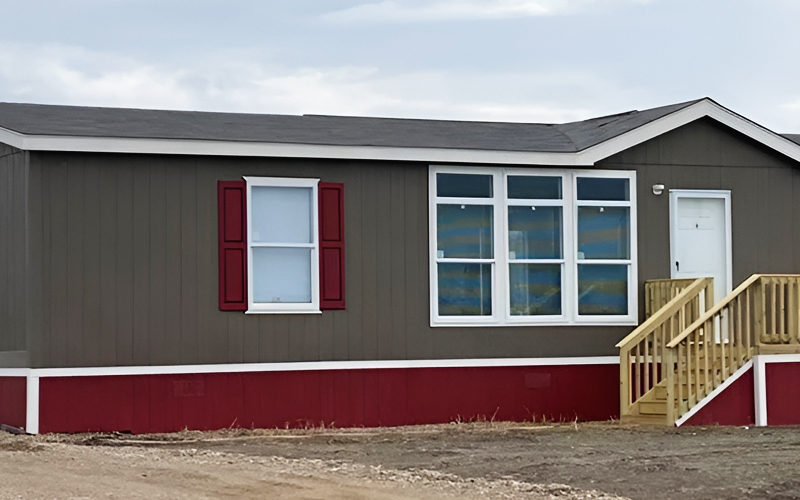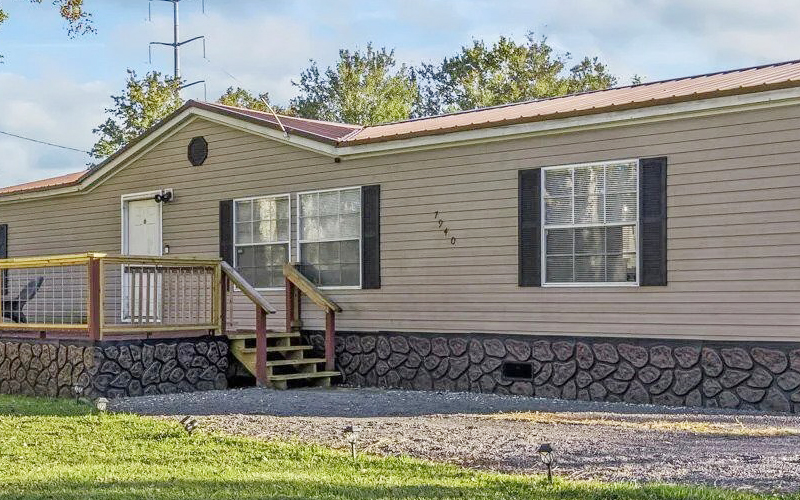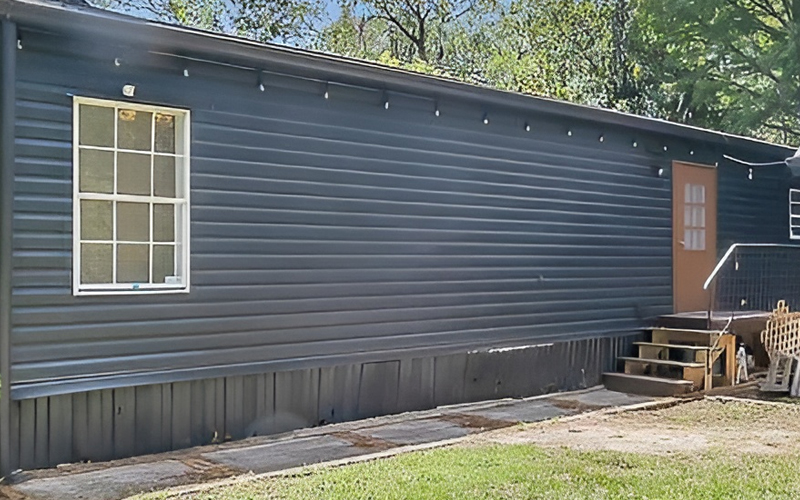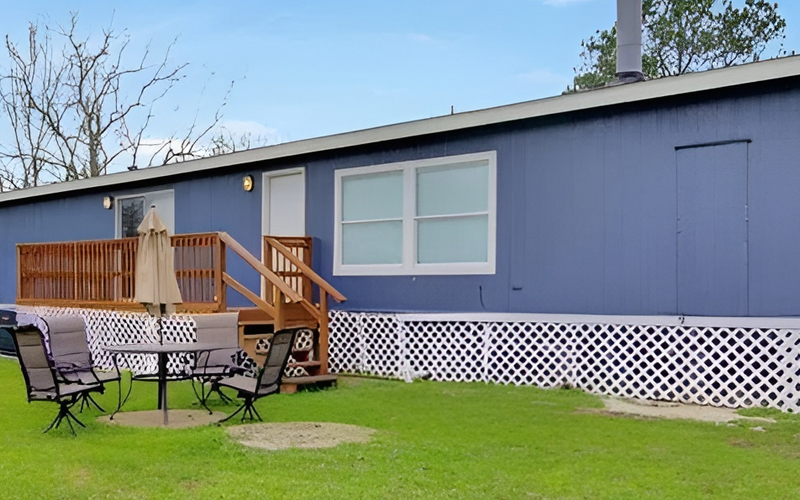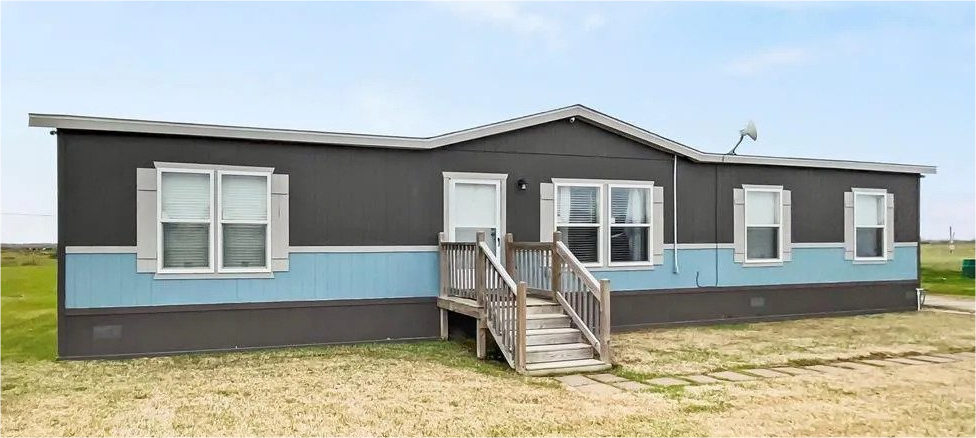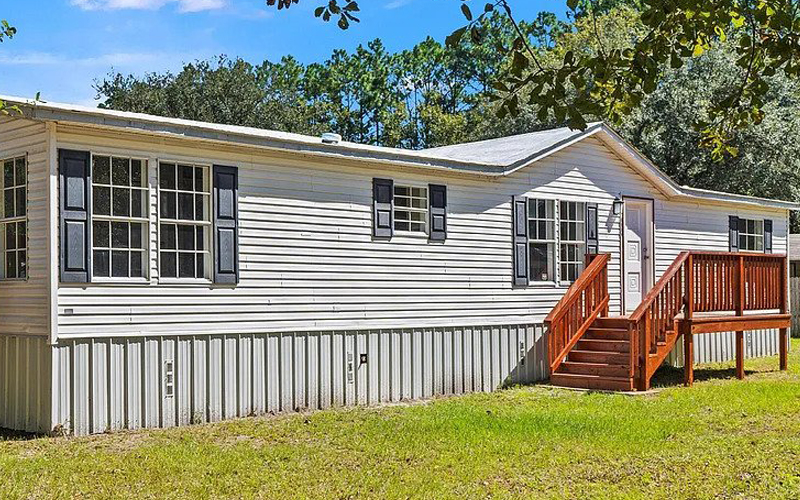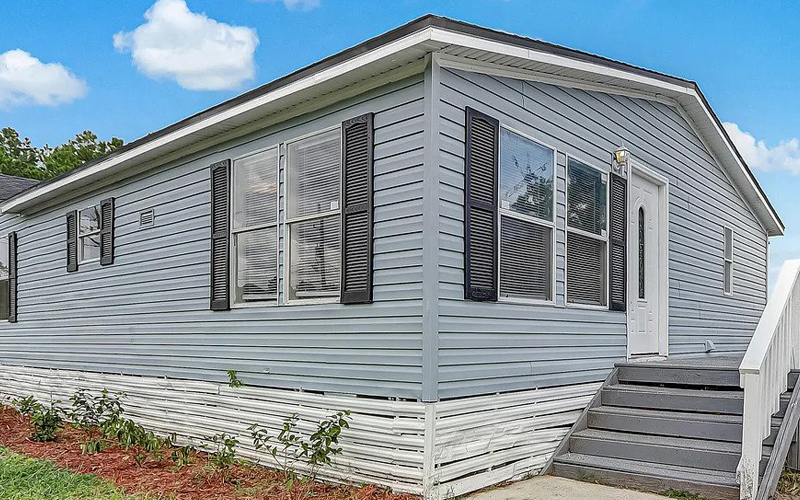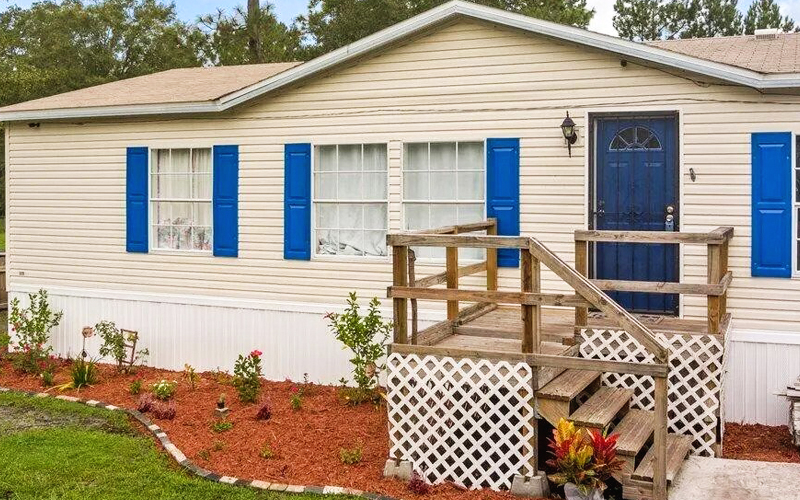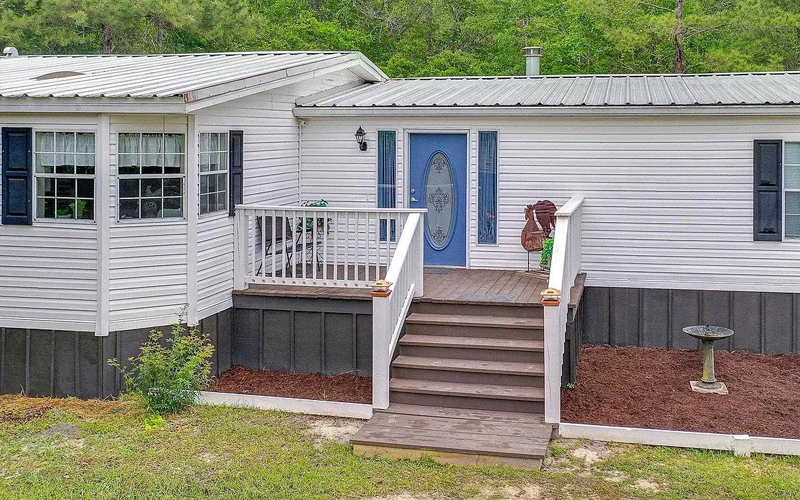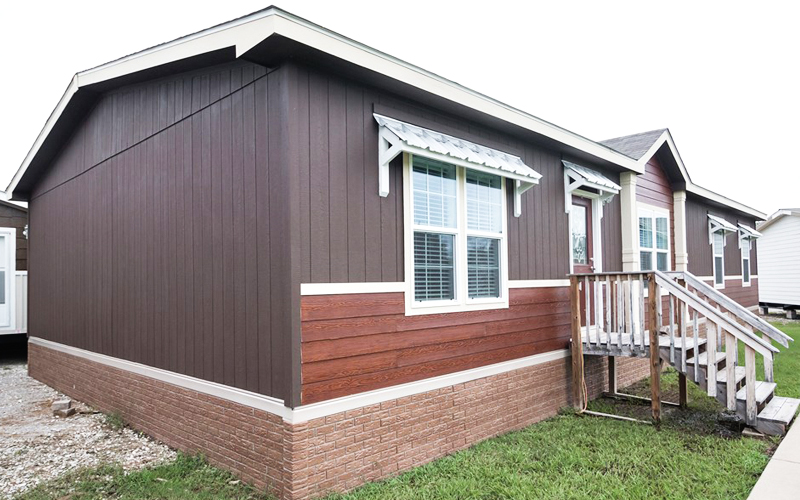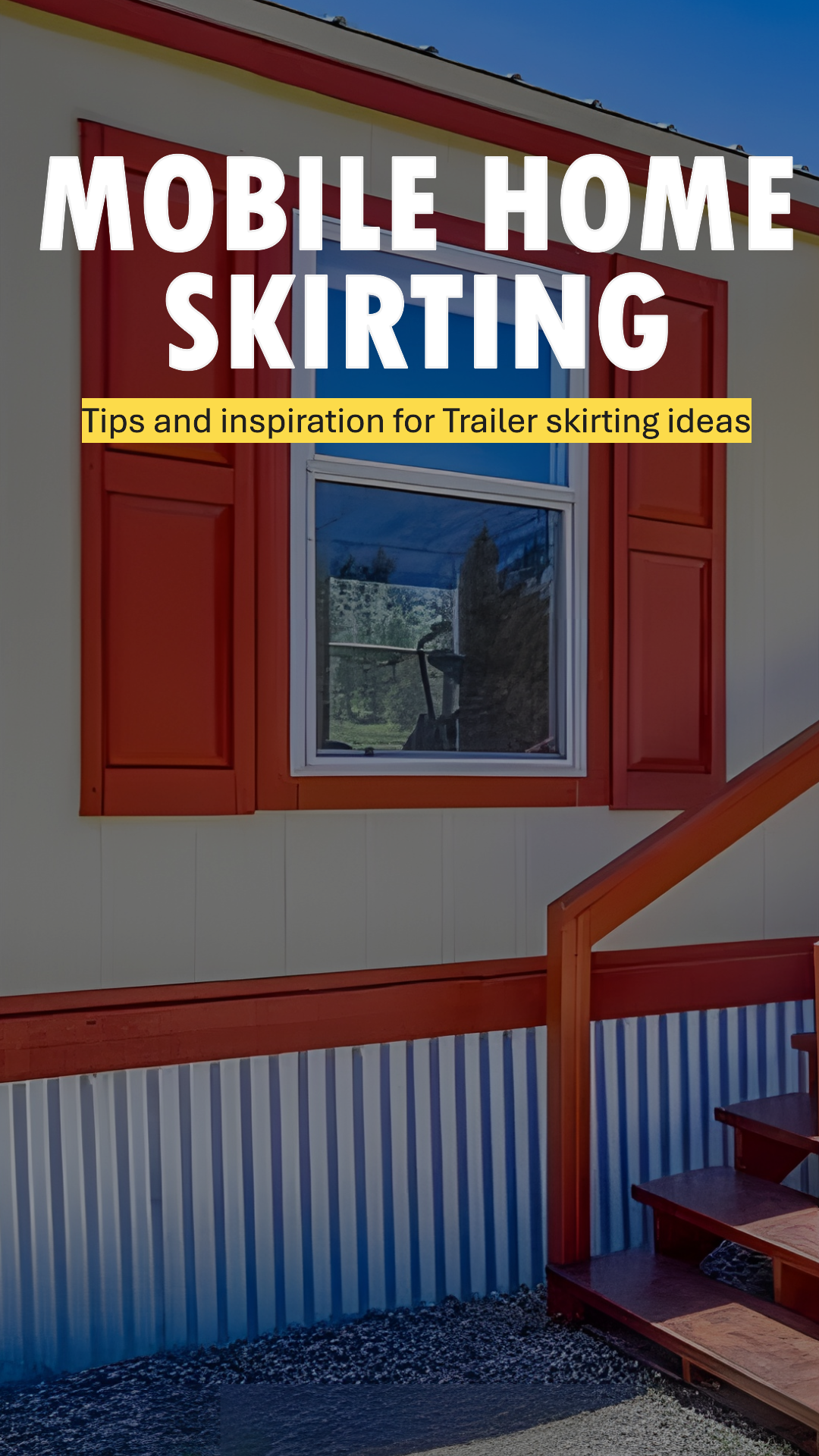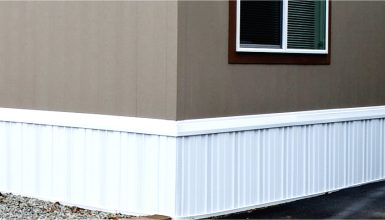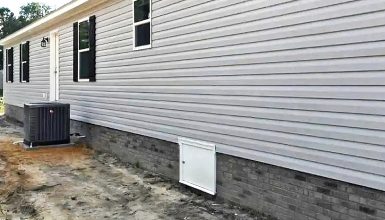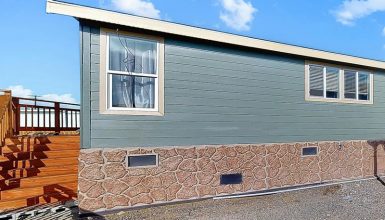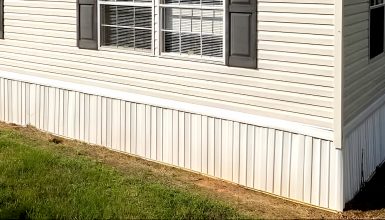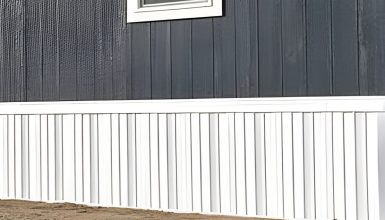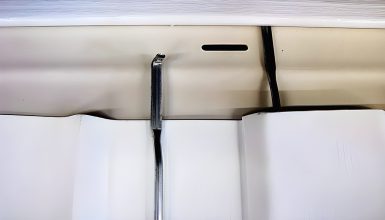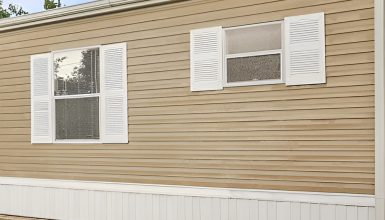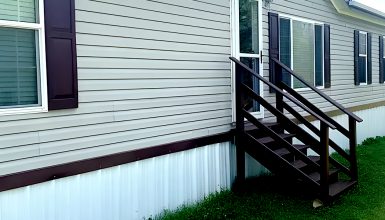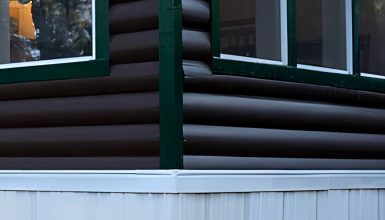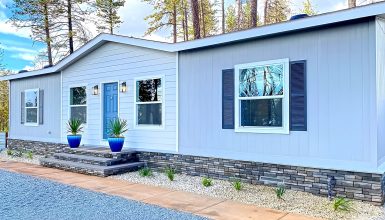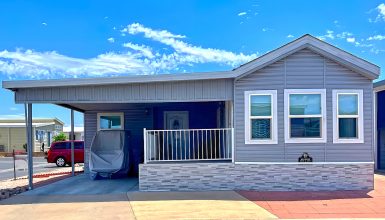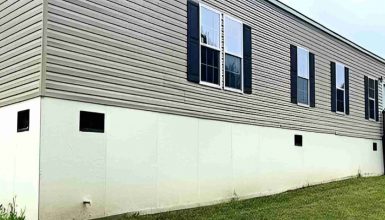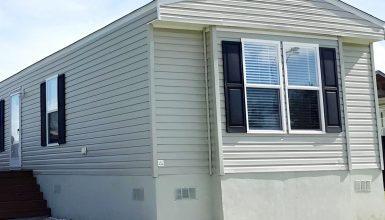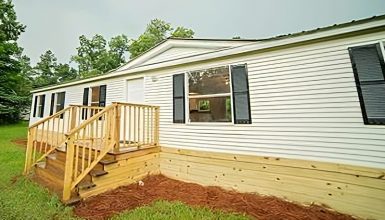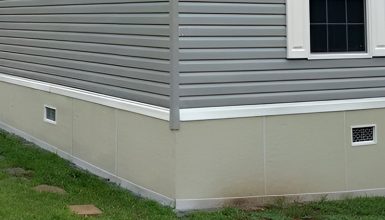Mobile home skirting is essential to the home’s overall construction, providing aesthetic and functional benefits. By enclosing the space underneath, skirting can help protect against pests and weather. It also helps prevent moisture buildup under the home, which can lead to mold, rot, and other damage over time. At the same time, the skirts improve the home’s overall appearance.
8 Mobile Homes Skirting Options
Several underpinning options are available for mobile homes, each with pros and cons. From vinyl and wood to brick and faux stone, your choice can significantly impact your home’s overall look and feel. Let’s dig deeper into the skirts for mobile homes!
1. Vinyl Skirting
For a good reason, vinyl skirting is one of the most popular options for mobile homes. It’s an affordable, durable, and low-maintenance choice that can give your home a polished look.
- Pros
The biggest pro of vinyl skirting is its affordability. It’s a budget-friendly option that won’t break the bank. It’s also easy to install, so you can save money by doing it yourself. Another advantage of vinyl skirting is that its low maintenance. Unlike wood or brick, it won’t rot or require repainting. Wash it down with a hose when it gets dirty, and you’re ready. Plus, it’s available in various colors and styles, so you can customize the look to match your home’s exterior.
- Cons
Of course, no product is perfect, and vinyl skirting panels have some cons. First, it’s not as sturdy as other options, such as metal or brick. It can be prone to damage from extreme weather, such as high winds or hail. Another disadvantage is that it can fade over time, especially if exposed to direct sunlight. And while it’s easy to clean, it can be challenging to repair if damaged. You may need to replace entire sections of the skirting, which can be costly.
- Cost
Vinyl skirting is one of the best affordable options available. Prices vary depending on the brand, style, and location, but on average, you can expect to pay between $5 and $10 per linear foot. Remember that installation costs can add to the total price. If you are uncomfortable installing it, you may also want to factor in those costs.
2. Metal Skirting
Metal is another popular choice skirt for mobile homes, and it’s not hard to see why. This sturdy and durable option provides excellent protection against the elements, making it a great choice for homes with high winds or extreme weather conditions.
- Pros
One of the top pros of metal skirting is its durability. Metal skirting won’t crack or rot over time, unlike vinyl or wood. It’s also resistant to pests, such as termites, that can cause damage to other materials. Additionally, metal skirting is fire-resistant, which can provide added peace of mind. Another advantage of metal skirting is that it’s available in various colors and finishes, so you can choose a look that matches your home’s exterior.
- Cons
Nevertheless, metal skirting does have a few cons to consider. First, it can be more expensive than other options, such as vinyl. It can also be more challenging to install, so you may need to hire a professional. Another disadvantage is that metal skirting can dent or scratch if hit with debris or heavy objects. Finally, it may require more maintenance than other materials, as it can rust over time.
- Cost
Metal skirting is generally more expensive than vinyl, but it can still be affordable. Prices vary depending on the brand, style, and location, but on average, you can expect to pay between $8 and $15 per linear foot. Remember that installation costs can add to the total price, so you may also want to factor in those costs.
3. Brick Skirting
Brick skirting is a popular option for mobile homes with a more traditional look. Made from real bricks and mortar, it can provide a classic and polished appearance to your home’s exterior.
- Pros
Unlike vinyl or wood, brick skirting won’t rot or require repainting. Additionally, it’s resistant to pests, such as termites, that can cause damage to other materials. Brick skirting is a durable option that can provide a classic look that won’t go out of style.
- Cons
It is the most expensive option, costing significantly more than vinyl or metal. It’s also more challenging to install, so you may need a professional to install it correctly. Another disadvantage is that it can be prone to cracking or crumbling over time, which can be costly.
- Cost
Brick skirting is significantly more expensive than other options. Prices vary depending on location, but you can expect to pay between $10 and $20 per square foot. It doesn’t include installation costs, which can be substantial.
4. Faux Stone Skirting
Faux stone skirting is a popular alternative to real stone that provides the look of natural stone at a lower cost. Made from a composite material like natural stone, it can give your mobile home a stylish and unique appearance.
- Pros
It’s more budget-friendly than natural stone, but it still looks similar. Additionally, faux stone is lightweight and easy to install, so you can save money by doing it yourself. It’s also available in various colors and styles, so you can customize the look to match your home’s exterior.
- Cons
Yet, faux stone skirting does have some downsides. The first is that it’s not as durable as natural stone. It can fade and crack over time, especially if exposed to direct sunlight. Another disadvantage is that it’s not as sturdy as other options, such as metal or brick. It can harm by debris or heavy objects, so you must be careful when maintaining it.
- Cost
Faux stone skirting is a more affordable option than natural stone. Prices vary depending on the brand, style, and location, but you can expect to pay between $10 and $15 per square foot.
5. Wood Skirting
Wood skirting is a popular option for mobile homes with a natural and traditional look. Made from real wood, it can give your home a warm and inviting appearance. However, there are several factors to consider before choosing wood skirting.
- Pros
One of the significant pros of wood skirting is its natural beauty. Wood provides a unique and rustic look that can be difficult to replicate with other materials. Additionally, wood skirting is a low-maintenance option that can be stained or painted to match your home’s exterior. It’s also relatively affordable compared to other natural materials like brick or stone.
- Cons
Wood skirting does have some downsides to consider. First, it’s not as durable as metal or brick. Wood can rot and warp over time, especially if exposed to moisture. Pests, like termites or carpenter ants, can also damage it and be costly. Additionally, wood skirting requires more maintenance than other materials, as it needs to paint or stained regularly to prevent damage.
- Cost
Wood skirting is more affordable than other natural materials like brick or stone. Prices vary depending on the type of wood and the location, but on average, you can expect to pay between $5 and $10 per square foot.
6. Cinder Block Skirting
Cinder block skirting is a popular option for mobile homes that want a sturdy and durable option that can provide excellent protection against the elements. Made from concrete blocks and mortar, it can give your home a solid and long-lasting appearance.
- Pros
A cinder block is a sturdy material that can withstand harsh weather conditions, including high winds and heavy rain. Additionally, cinder block is resistant to pests like termites and carpenter ants, which can cause damage to other materials. Cinder block skirting is also a low-maintenance option that requires little upkeep over time.
- Cons
It’s less visually appealing than other options like brick or stone. Cinder block is a functional material that doesn’t provide the same beauty or charm as other materials. Additionally, cinder block skirting can be more challenging to install than other options, so you may need to hire a professional.
- Cost
Cinder block skirting is generally more expensive than vinyl or wood. Prices vary depending on the location and size of the job, but on average, you can expect to pay between $8 and $12 per square foot.
7. Lattice Skirting
Lattice skirting is a popular option for decorative and affordable enclosing the space underneath. It is a crisscross pattern made from thin strips of wood, vinyl, or metal that can provide a decor appearance to your home’s exterior. However, there are several factors to consider before choosing lattice skirting.
- Pros
It’s a budget-friendly option that won’t break the bank. The lattice is also available in various designs and styles, so you can customize the look to match your home’s exterior. It’s also lightweight and easy to install, making it a great DIY project.
Another advantage of lattice skirting is that it provides ventilation to the underside of the home. It can help prevent moisture buildup and improve airflow, benefiting mobile homes in humid areas.
- Cons
First is that it’s not as durable as other materials like metal or brick. Lattice can be prone to warping or damage over time, especially if exposed to extreme weather conditions. Pests like termites or rodents can easily damage it. Additionally, lattice skirting may require more maintenance than other materials, as it needs to stain regularly to prevent damage.
- Cost
Lattice skirting is one of the most affordable options available. Prices vary depending on the material and location. Still, on average, you can expect to pay between $2 and $5 per square foot.
8. Concrete Skirting
Concrete skirting is a durable, long-lasting option for mobile homes that provides a solid and secure barrier. Made from precast concrete blocks or poured concrete, it can provide insulation and protection for the home.
- Pros
It is a sturdy material that can withstand harsh weather conditions and provide long-lasting protection for the home. It’s also an excellent option for mobile homes in areas prone to natural disasters like hurricanes or tornadoes. Additionally, this skirting is resistant to pests, moisture, and other potential problems that can be challenging for different materials.
- Cons
While concrete is a versatile material, it has limited design options for skirting. Also, its high cost and complicated installation make it a less practical choice for some homeowners.
- Cost
You can expect to pay between $10 and $20 per square foot for concrete skirting, which can add up quickly for larger homes. This cost includes the price of the materials, labor, and installation, which requires specialized equipment and expertise
How to Choose a Mobile Home Skirting?
When choosing skirts for mobile homes, you must consider several factors to make the right choice. Here are a few tips to help you choose the best underpinning for your mobile home:
- Consider your budget
Skirting materials vary widely in cost, so it’s essential to determine how much you’re willing to spend before making a decision. Remember that more expensive materials like brick or stone will likely require professional installation, which can add to the total cost.
- Think about the climate.
If you live in an area with harsh weather conditions, you’ll want to choose skirting that can withstand the elements. Materials like metal or cinder blocks may better suit regions with high winds or heavy rain.
- Consider the style
The skirting you choose should complement the overall style of your mobile home. Materials like brick or wood may be a good choice for a traditional look. Conversely, materials like metal or vinyl may be better if you want a more modern look.
- Look at maintenance requirements.
Some skirting materials require more maintenance than others. For example, wood or plywood may need to paint or stained regularly to prevent damage. At the same time, materials like metal or cinder blocks may require less upkeep over time.
- Think about the installation process.
Some skirting materials are easier to install than others. Materials like vinyl or plywood may be a good choice if you’re comfortable with DIY projects. If you’re uncomfortable with installation, materials like brick or stone may require professional help.
Considering these factors, you can choose the best skirting for your mobile home that meets your needs and budget.
Mobile Home Skirting Ideas
Below we will explore some pictures of creative and unique mobile home skirting ideas that can inspire you. We’ll cover everything from modern and sleek options to more traditional and rustic skirts. With so many underpinning ideas, you will find the perfect fit for your mobile home.
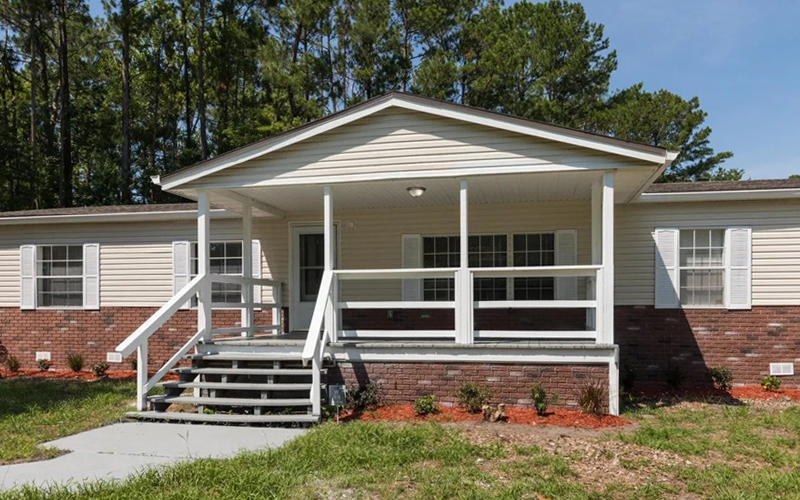
Skirts are an essential part of any mobile home. It improves the home’s overall appearance and serves several functions, improving insulation and preventing moisture buildup. With so many skirting options available, it’s essential to consider factors like budget, climate, and maintenance requirements when choosing the best fit for your home. Thank you for reading!

